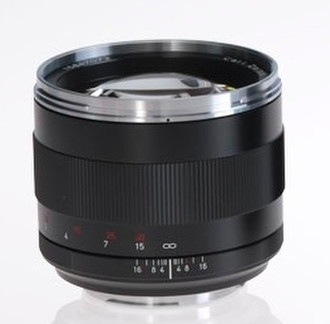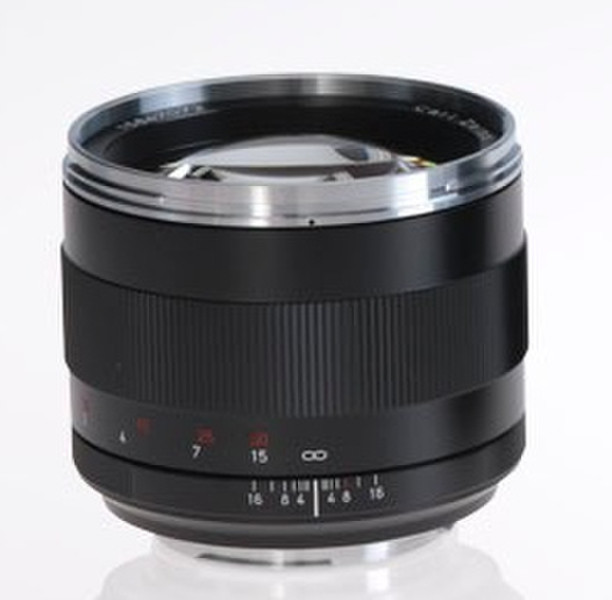目錄的
-
目錄的
- Antiquitäten & Kunst
- Auto & Motorrad: Fahrzeuge
- Baby
- Bücher
- Camping & Outdoor
- Feinschmecker
- Haustierbedarf
- Heimwerken & Garten
- IT和电子
- Kleidung & Accessoires
- Modellbau
- Musik
- PC- & Videospiele
- Sammeln & Seltenes
- Spielzeug
- TV, Video, DVD
- Telekommunikation
- Uhren & Schmuck
- Wellness & Beauty
- fashion & lifestyle
- institutional food services equipment
- medical equipment, accessories & supplies
- 个人护理
- 休闲爱好
- 办公设备,用品和配件
- 商业与工业
- 家居,建筑,装修
- 家用电器
- 摩托车及配件
- 武器和弹药
- 照相机
- 花园和庭院
- 运动,娱乐及休闲
- 食物
- 高保真音響
Filters
Search
Carl Zeiss Planar T* 1.4/85 SLR Standard lens Black
凡购买和价格 (Advertising *)
顶部
技术特点
顶部
重量和尺寸
| 直径 | 77 mm |
|---|
聚焦系统
| 固定焦距 | 85 mm |
|---|---|
| 光圈范围 | 1.4 - 16 |
| 最近聚焦距离 | 1 m |
| 组件应用 | SLR |
另外
| 镜头结构(元素 /组) | 6/5 |
|---|
Planar T* 1.4/85 (ZE) EF Mount
Pinpoints of light in the background envelop the individual and conceal a mysterious message. The Planar T* 1,4/85 lens brings out the best in its subject, while masterfully manipulating both sharpness and soft focus.
This classic portrait lens captures people in their surroundings, playing with a range of sharpness, soft focus and contrast effects. Its distinctive circular bokeh is a crucial creative element. The Planar T* 1,4/85 produces very high quality and shallow depth-of-field when wide open. This is especially suitable for isolating the main subject from the foreground and background. This lens is also suitable as a general-purpose lens.
The famous symmetric lens design invented by Dr. Paul Rudolph at Carl Zeiss in 1896. The Planar lens is the most successful camera lens design – and, by the way, the most plagiarized – ever created. It provides the lens designer with numerous means to correct aberrations extraordinarily well. And its performance is very constant over a wide range of imaging ratios, enabling such a versatile lens variety as the Makro-Planar lens.
<b>Floating Elements Design</b>
State-of-the-art camera techniques and high-resolution digital image sensors increasingly demand more from the lenses. The modern floating element design compensates aberrations of the Carl Zeiss SLR lenses at different distance settings. This is accomplished by changing the axial distance of single lens elements or element groups to each other. The adjustment of the element distance is coupled to the distance setting so that it always results in the right correction. The mechanical design of these lens elements is very complex and the workmanship must be particularly exact – both specialties of Carl Zeiss.
<b>Excellent image quality</b>
The Carl Zeiss range of T* lenses offers the highest possible standards in terms of performance, reliability and, of course, image quality. Quite simply, they are superior in every way. You can count on highly advanced flare control for crisp and brilliant images, for example. And virtually zero geometric distortion, ensuring precise accuracy when reproducing shapes – especially useful when photographing products and architecture.
<b>Elaborate stray light reduction</b>
Rich, vibrant colors are vital to creating a lasting impression. Stray light in the lens, however, would lead to a brightening of the image, which is particularly visible in shadow areas. Image contrast is lowered; the image appears dull and bleached. We combine various, elaborate techniques to reduce unwanted stray light. For example, all lens elements are coated with the famous Carl Zeiss T* anti-reflective coating. Additionally, a jet black special paint is applied by hand to all lens element edges to ensure that reflections are prevented from the start.
<b>Precise manual focus</b>
Manually focusing a lens means controlling the image result from your fingertips. A good ergonomic design makes all the difference. Carl Zeiss SLR lenses stand out with their large rotation angle which enables precise focusing. Changes are immediately visible in the viewfinder. The high-quality focusing mechanism moves smoothly without play, thus also supporting the intuitive interaction with the focal plane. The precise engraving in meter and feet, and the depth of focus scale provide additional support for manually focusing.
<b>Carl Zeiss T* anti-reflective coating</b>
All lens elements in SLR lenses from Carl Zeiss feature the T* anti-reflective coating and an optical design that produces brilliant pictures even in unfavorable lighting conditions. We vacuum deposit very thin, transparent coats on the surfaces of the lens elements to make them anti-reflective. Special substances, one by one, are vaporized with very high energy in a high vacuum, which are then deposited on the glass surface as a coating with precisely controlled thicknesses to achieve the desired reduction of reflections. The first coatings were applied by Carl Zeiss back in the 1930s.
This classic portrait lens captures people in their surroundings, playing with a range of sharpness, soft focus and contrast effects. Its distinctive circular bokeh is a crucial creative element. The Planar T* 1,4/85 produces very high quality and shallow depth-of-field when wide open. This is especially suitable for isolating the main subject from the foreground and background. This lens is also suitable as a general-purpose lens.
The famous symmetric lens design invented by Dr. Paul Rudolph at Carl Zeiss in 1896. The Planar lens is the most successful camera lens design – and, by the way, the most plagiarized – ever created. It provides the lens designer with numerous means to correct aberrations extraordinarily well. And its performance is very constant over a wide range of imaging ratios, enabling such a versatile lens variety as the Makro-Planar lens.
<b>Floating Elements Design</b>
State-of-the-art camera techniques and high-resolution digital image sensors increasingly demand more from the lenses. The modern floating element design compensates aberrations of the Carl Zeiss SLR lenses at different distance settings. This is accomplished by changing the axial distance of single lens elements or element groups to each other. The adjustment of the element distance is coupled to the distance setting so that it always results in the right correction. The mechanical design of these lens elements is very complex and the workmanship must be particularly exact – both specialties of Carl Zeiss.
<b>Excellent image quality</b>
The Carl Zeiss range of T* lenses offers the highest possible standards in terms of performance, reliability and, of course, image quality. Quite simply, they are superior in every way. You can count on highly advanced flare control for crisp and brilliant images, for example. And virtually zero geometric distortion, ensuring precise accuracy when reproducing shapes – especially useful when photographing products and architecture.
<b>Elaborate stray light reduction</b>
Rich, vibrant colors are vital to creating a lasting impression. Stray light in the lens, however, would lead to a brightening of the image, which is particularly visible in shadow areas. Image contrast is lowered; the image appears dull and bleached. We combine various, elaborate techniques to reduce unwanted stray light. For example, all lens elements are coated with the famous Carl Zeiss T* anti-reflective coating. Additionally, a jet black special paint is applied by hand to all lens element edges to ensure that reflections are prevented from the start.
<b>Precise manual focus</b>
Manually focusing a lens means controlling the image result from your fingertips. A good ergonomic design makes all the difference. Carl Zeiss SLR lenses stand out with their large rotation angle which enables precise focusing. Changes are immediately visible in the viewfinder. The high-quality focusing mechanism moves smoothly without play, thus also supporting the intuitive interaction with the focal plane. The precise engraving in meter and feet, and the depth of focus scale provide additional support for manually focusing.
<b>Carl Zeiss T* anti-reflective coating</b>
All lens elements in SLR lenses from Carl Zeiss feature the T* anti-reflective coating and an optical design that produces brilliant pictures even in unfavorable lighting conditions. We vacuum deposit very thin, transparent coats on the surfaces of the lens elements to make them anti-reflective. Special substances, one by one, are vaporized with very high energy in a high vacuum, which are then deposited on the glass surface as a coating with precisely controlled thicknesses to achieve the desired reduction of reflections. The first coatings were applied by Carl Zeiss back in the 1930s.
-
支付方式
我们接受:











